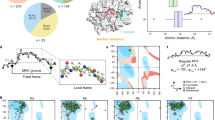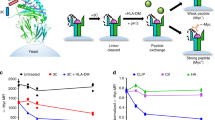Abstract
Peptides that are antigenic for T lymphocytes are ligands for two receptors, the class I or II glycoproteins that are encoded by genes in the major histocompatibility complex, and the idiotypic α/β chain T-cell antigen receptor1-9. That a peptide must bind to an MHC molecule to interact with a T-cell antigen receptor is the molecular basis of the MHC restriction of antigen-recognition by T lymphocytes10,11. In such a trimolecular interaction the amino-acid sequence of the peptide must specify the contact with both receptors: agretope residues bind to the MHC receptor and epitope residues bind to the T-cell antigen receptor12,13. From a compilation of known antigenic peptides, two algorithms have been proposed to predict antigenic sites in proteins. One algorithm uses linear motifs in the sequence14, whereas the other considers peptide conformation and predicts antigenicity for amphipathic α-helices15,16. We report here that a systematic delimitation of an antigenic site precisely identifies a predicted pentapeptide motif as the minimal antigenic determinant presented by a class I MHC molecule and recognized by a cytolytic T lymphocyte clone.
This is a preview of subscription content, access via your institution
Access options
Subscribe to this journal
Receive 51 print issues and online access
$199.00 per year
only $3.90 per issue
Buy this article
- Purchase on Springer Link
- Instant access to full article PDF
Prices may be subject to local taxes which are calculated during checkout
Similar content being viewed by others
References
Thomas, D. W., Hsieh, K.-H., Schauster, J. L. & Wilner, G. D. J. exp. Med. 153, 583–594 (1981).
Shimonkevitz, R., Kappler, J., Marrack, P. & Grey, H. J. exp. Med. 158, 303–316 (1983).
Babbitt, B., Allen, P., Matsueda, G., Haber, E. & Unanue, E. Nature 317, 359–361 (1985).
Shastri, N., Oki, A., Miller, A. & Sercarz, E. E. J. exp. Med. 162, 332–345 (1985).
Townsend, A. et al. Cell 44, 959–968 (1986).
Bjorkman, P. J. et al. Nature 329, 506–518 (1987).
Buus, S., Sette, A., Colon, S., Miles, C. & Grey, H. Science 235, 1353–1358 (1987).
Marrack, P. & Kappler, J. Science 238, 1073–1079 (1987).
Davis, M. M. & Bjorkman, P. J. Nature 334, 395–402 (1988).
Zinkernagel, R. M. & Doherty, P. C. Adv. Immun. 27, 51–177 (1979).
Schwartz, R. H. A. Rev. Immun. 3, 237–262 (1985).
Allen, P. M. et al. Nature 327, 713–715 (1987).
Rothbard, J. B. et al. Cell 52, 515–523 (1988).
Rothbard, J. B. & Taylor, W. R. EMBO J. 7, 93–100 (1988).
DeLisi, C. & Berzofsky, J. Proc. natn. Acad. Sci. U.S.A. 82, 7048–7052 (1985).
Margalit, H. et al. J. Immun. 138, 2213–2229 (1987).
Reddehase, M. J. & Koszinowski, U. H. Nature 312, 369–371 (1984).
Keil, G. M., Ebeling-Keil, A. & Koszinowski, U. H. J. Virol. 61, 1901–1908 (1987).
Koszinowski, U. H., Keil, G. M., Schwarz, H., Schickedanz, J. & Reddehase, M. J. J. exp. Med. 166, 289–294 (1987).
Volkmer, H., Bertholet, C., Jonjic, S., Wittek, R. & Koszinowski, U. H. J. exp. Med. 166, 668–677 (1987).
Del Val, M. et al. J. Virol. 62, 3965–3972 (1988).
Reddehase, M. J., Bühring, H.-J. & Koszinowski, U. H. J. Virol. 57, 408–412 (1986).
Reddehase, M. J. et al. Immunobiology 174, 420–431 (1987).
Bodmer, H. C., Pemberton, R. M., Rothbard, J. B. & Askonas, B. A. Cell 52, 253–258 (1988).
Schwartz, R. H., Fox, B. S., Fraga, E., Chen, C. & Singh, B. J. Immun. 135, 2598–2608 (1985).
Good, M. F. et al. J. Immun. 140, 1645–1650 (1988).
Oldstone, M. B. A., Whitton, J. L., Lewicki, H. & Tishon, A. J. exp. Med. 168, 559–570 (1988).
Sette, A. et al. Nature 328, 395–399 (1987).
Author information
Authors and Affiliations
Rights and permissions
About this article
Cite this article
Reddehase, M., Rothbard, J. & Koszinowski, U. A pentapeptide as minimal antigenic determinant for MHC class I-restricted T lymphocytes. Nature 337, 651–653 (1989). https://doi.org/10.1038/337651a0
Received:
Accepted:
Issue Date:
DOI: https://doi.org/10.1038/337651a0
Comments
By submitting a comment you agree to abide by our Terms and Community Guidelines. If you find something abusive or that does not comply with our terms or guidelines please flag it as inappropriate.



